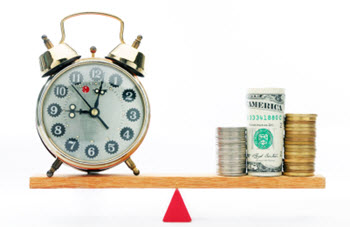Financial instruments for FX trading
Foreign Exchange Spot (FX spot)
In an FX spot transaction, the buyer purchases a certain amount of a certain currency from the seller, and the seller is paid in another currency than the purchased currency. The exchange rate used for an FX spot is called spot exchange rate.
 FX spot transactions form the foundation of the FX market and it would be difficult to imagine an FX market without FX spot transactions. It is one of the most common transaction types on the FX market and enormous amounts of currency is changing hands through FX spot transactions each trading day. Statistics from 2013 show us that in that year, the average daily turnover for FX spot transactions reached the equivalent of nearly 2 trillion United States Dollars (USD).
FX spot transactions form the foundation of the FX market and it would be difficult to imagine an FX market without FX spot transactions. It is one of the most common transaction types on the FX market and enormous amounts of currency is changing hands through FX spot transactions each trading day. Statistics from 2013 show us that in that year, the average daily turnover for FX spot transactions reached the equivalent of nearly 2 trillion United States Dollars (USD).
When an FX spot transaction is agreed on, the sold currency is delivered to the buyer right away, but the buyer will not have to deliver payment to the seller until later, on the so called spot date. The spot date is usually one or two bank dates after the sell date. For FX spots that involves the currency USD + Euro, Canadian dollars, Russian rubles or Turkish lira, the standard spot date is one bank date after the sell date. This is expressed as T + 1. For other currency pairs, the standard is instead to have a spot date that falls two bank days after the sell date (T + 2).
Foreign Exchange Option (FX option)
The holder of an FX option has a right, but not an obligation, to carry out the specified FX transaction.
The FX option documentation will, among other things, include information on the currencies involved and the exchange rate. The exchange rate is called the strike price.
Example: This FX Option gives the holder the right to exchange 1 million USD for 8.25 million NOK on July 1st, 2017. (The strike price for that option is 8.25.)
The issuer of an FX option is the entity that is obliged to honor the option, should the holder decide to exercise the option.
What’s the premium?
When the issuer of an option sells the option, the purchase prices is known as the premium.
When can I exercise my FX option?
An American-style FX option can be exercised on any day until the option has expired. A European-style FX option can only be exercised on the expiry date.
FX options that are neither American-style nor European-style are called exotic FX options. Within this category, we will for instance find the Bermuda-style FX option, which can be exercised on certain pre-determined dates during the lifetime of the option.
Foreign Exchange Forward (FX forward)
A forward is a contract where two counterparts agree to transfer ownership of a predetermined asset for a predetermined price at a predetermined future date. Asset-transfer and payment takes place on the same date. Unlike an option, a forward is binding for both parties.
Foreign Exchange Future (FX future)
 FX futures are similar to FX forwards, but with a higher degree of standardization. An FX forward is normally created to fit the specific needs to two specific parties. An FX future is created for speculation and should ideally be appealing to a wide range of buyers. A high degree of standardization is required to facilitate efficient trading.
FX futures are similar to FX forwards, but with a higher degree of standardization. An FX forward is normally created to fit the specific needs to two specific parties. An FX future is created for speculation and should ideally be appealing to a wide range of buyers. A high degree of standardization is required to facilitate efficient trading.
One example of the standardization of FX futures is the fact that for a vast majority of all FX futures, the expiry date falls on the third Wednesday of March, June, September or December.
Since FX futures are standardized, they are not just traded over-the-counter but on certain exchanges as well. You can for instance trade in FX futures at the International Commercial Exchange (in New York), at the International Monetary Market (a division of the Chicago Mercantile Exchange), at the Euronext NV (in Amsterdam), and at the Tokyo Financial Exchange.
Foreign Exchange Swap (FX swap)
A foreign exchange swap is essentially an FX spot + an FX forward, bundled into the same contract. The two parties agree to swap currencies with each other for a predetermined time. When the time is over, they will swap back. Un FX swap is binding for both parties.
N.B! An FX swap is not the same thing as a currency swap. With a currency swap, two parties swap interest rates and/or amortizing payments for loans in different currencies.
Foreign Exchange Certificate (FEC)
 A foreign exchange certificate (FEC) is a bit similar to an FX option, because the holder of a FEC has a right but not an obligation to convert a certain amount of one currency into another at a predetermined exchange rate. It is only the issuer of the FEC that is bound by the FEC.
A foreign exchange certificate (FEC) is a bit similar to an FX option, because the holder of a FEC has a right but not an obligation to convert a certain amount of one currency into another at a predetermined exchange rate. It is only the issuer of the FEC that is bound by the FEC.
Most FEC:s can be exercised on any date until they have expired, but there are those that diverge from this norm and it is always important to check the FEC documentation before you purchase any FEC.
A FEC can be used to mitigate currency risk (you know the exchange rate in advance) but are also bought and sold for speculative purposes. In addition to this, FEC:s can be issued by a government as a type of surrogate for the national currency – typically because the national currency is non-convertible or subjected to very strict exchange controls. The Cuban convertible peso is for instance in essence a type of FEC and a surrogate for the non-convertible Cuban peso.
This article was last updated on: June 17, 2016